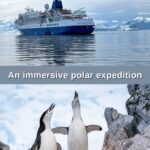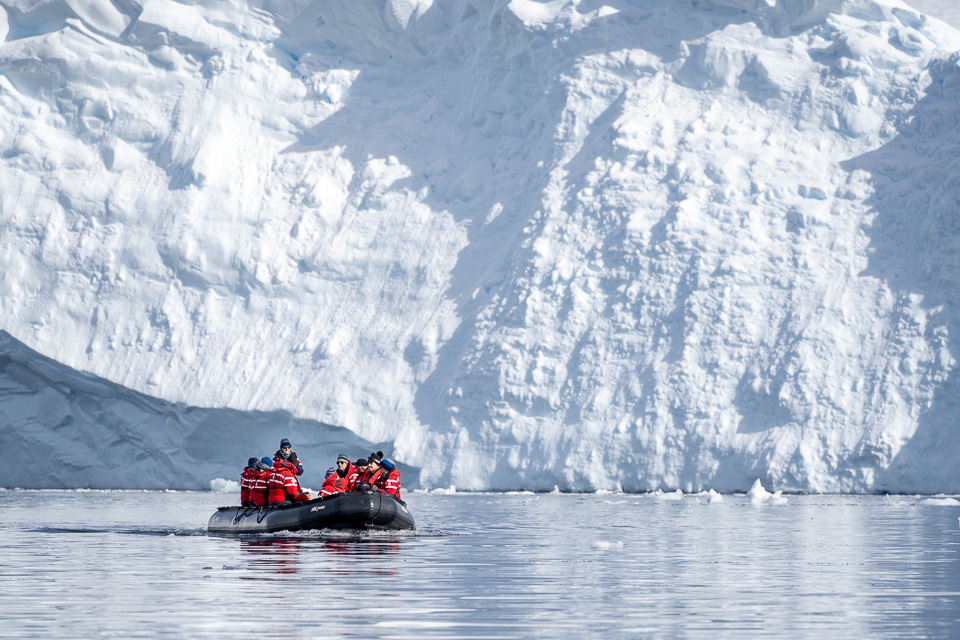
We don't want to overstate the case with our title ‘Best Antarctica Cruise', because this was our first Antarctica cruise. But we know an exceptional experience when we’re in the middle of it, and this immersive polar expedition with Polar Latitudes was outstanding.
Our travel to Antarctica in February 2024 marked our seventh continent. It was all new to us. As soon as we announced the trip, we were peppered with questions from our friends and readers – which only added to our wonder and anticipation. For example:
-
- “How do you get there?”
- “What about the infamously rough Drake Passage?” (alternately expressed as, “I'd go, but my spouse/partner/s.o. can't handle being seasick.”)
- “It's cold there, isn't it?”
- “I hear the penguins are really smelly. Ick.”
OK, we’ll cover all that.
Before we booked the trip, we had very few answers. Even packing was strange. But just a few weeks later we are full of images, information, and respect for the expedition team, the ship's crew members, and the explorers who’ve gone before. Polar Latitudes guided us through it all, including the advance preparations and the follow-up resources. So we’ll start at the beginning.
Table of Contents
Why Go to Antarctica?
Antarctica has a lot of nicknames, like a good friend or maybe like a revered someone whose name we dare not speak. The White Continent, the Last Wilderness, Land of Penguins, the Crystal Desert, or just The Ice, as in “I was on The Ice last week.”
For explorers, for adventurers, for fans of nature, marine biology, or ornithology; for lovers of big water, big skies, huge landscapes, Antarctica is the last frontier. It has drawing power the size of a…continent. It’s not that today’s visitors are going where no man has gone before, but they are seeing sights they’ve never seen before in a place only very few people have journeyed before. As Polar Latitudes puts it, “we are all explorers.”
Antarctica is there, and for many, that it enough. Even those who hesitate, thinking of the time it takes to get there, the expense (real or perceived), the storied seas, and the cold, dream on it. If you want to go, you can travel to Antarctica these days in relative comfort, surrounded by astounding scenery, and up close with the rich wildlife.
If we can do it, so can you.
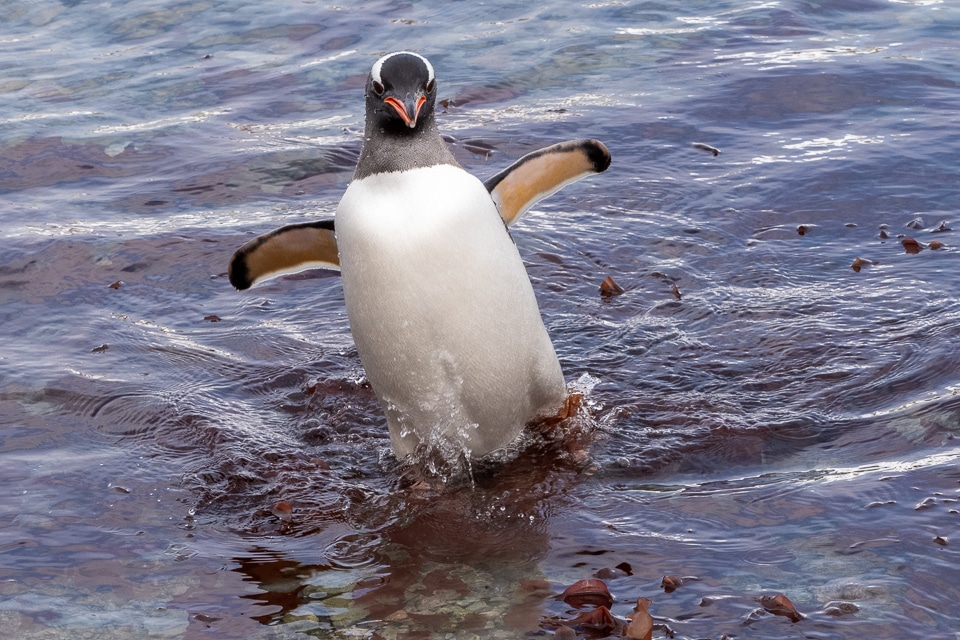
Tourism to Antarctica and IAATO
Tourism to Antarctica and making the journey safe and comfortable for passengers has only taken hold in the past couple decades. In the early 1990s, fewer than 7,000 visitors landed on the ice. This season Antarctica will see more than 100,000 visitors.
The framework for all this growth started with the Antarctic Treaty of 1959. Basically, the point was to prevent any country or entity from staking claims on the continent. These days, some 70 research stations operated by about 30 countries are scattered across Antarctica, peacefully co-existing.
In 1991, the Antarctic Environment Protocol was established as part of that Treaty, detailing stringent standards to protect the Antarctic environment. And that led to the founding of the International Association of Antarctica Tour Operators (IAATO), “a global, non-profit industry alliance dedicated to safe and responsible private-sector travel to the White Continent,” in their own words.
At the time, there were seven companies operating expeditions to Antarctica. Today there are more than 100 IAATO members, including not only the tour operators but the travel agents, associated businesses, and non-profits, all interested in examining and minimizing the impact of their travel industry on the fragile Antarctic environment.
The result for would-be visitors is that travel to Antarctica is highly regulated. There are restrictions to visiting popular landing sites based on timing, frequency, and number of passengers. That's why you'll want to select the IAATO member company with the size and type of ship that will suit your style.
Choosing an Expedition Ship versus a Cruise Line
Anyone choosing a company with whom to travel to Antarctica will eventually learn about IAATO. The first tip we’ll give is to choose a company that really embraces the IAATO guidelines, promotes them, and works with others in the industry to uphold them.
We chose Polar Latitudes partly because of their oversized involvement in IAATO, and also because they focus exclusively on Antarctica. We prefer to book and travel directly with tour operators, especially in a novel expedition like this. Our decision to go with Polar Latitudes was strengthened by the fact it is a founder-owned and operated company. There's nothing like experienced leadership to reassure us. And with adventure travel, there's nothing like an experienced staff to guide and teach us inexperienced “beginners.”
 Want more tips like these?
Want more tips like these?
Join the 3500 other travel enthusiasts getting our best advice right in their inbox. And get our 50 best travel tips sent to you right away!
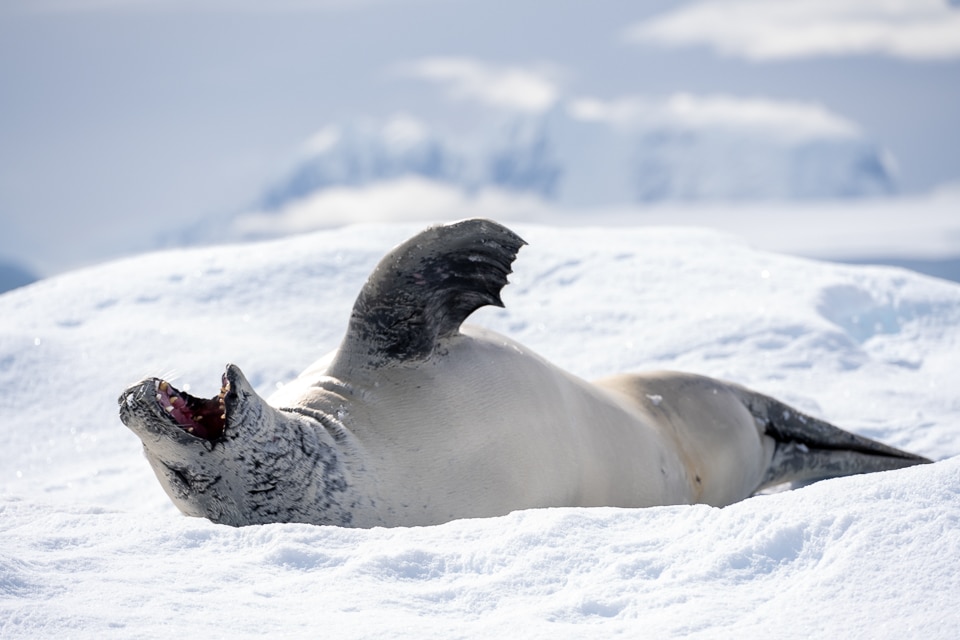
Expedition Ships
Choosing an expedition style cruise means selecting an expedition ship. The purpose-built MS Seaventure, operated in Antarctica by Polar Latitudes, is one of the smaller expedition ships in the polar waters. It has a 1-A Super ice class rating which we know nothing about except that it’s the highest ice class awarded to passenger vessels. Capacity is just 138 passengers, well under the 200 threshold that allows smaller ships special privileges in navigating the area.
We were loaded with 16 kayaks and 14 zodiacs, plus dry suits for kayakers’ use, camping gear for 50, and muck boots for all, making this immersive expedition possible.
While passenger experiences are top of mind, it’s great to know that this working vessel is also regularly transporting scientists, researchers, staff, and supplies to “The Ice.”
By definition, expedition ships are actively involved in research and supporting science organizations. (See more about this below.) So Seaventure has science lab space, citizen science programs connected to world renowned organizations, and a highly accessible staff who enjoy offering presentations on their areas of expertise. We most enjoyed that this well educated and experienced staff (full of personality, too) were open to eating with passengers or just hanging out on the deck to help us newcomers see and understand what we’re seeing.
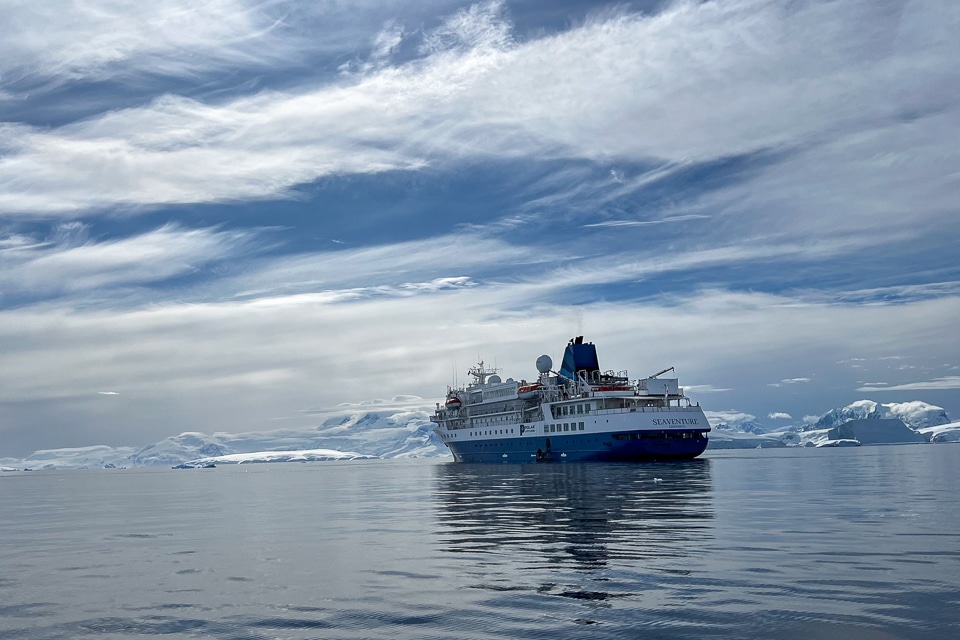
Cruise-Only Visits
Familiarizing yourself with some basic IAATO regulations will also inform your choice of tour operators or cruise lines. For instance, no more than a hundred people are allowed on land at a time at the landing sites. So from larger ships (200-500 passengers), even if they are expedition style, zodiac trips ashore are limited. Not everyone who wants to go ashore can be delivered there at one time, which means fewer opportunities per passenger.
Ships with more than 500 passengers are not allowed to land or put passengers ashore at all. These big Antarctica cruise ships offer cruise-only visits, sort of a drive-by approach to Antarctica. For those looking for a luxury cruise experience, larger vessels, and entertainment, this is an option.
Of the nearly 110,000 visitors estimated to visit the continent this season, about 70,000 will have stepped on land.
Planning a trip to Antarctica? We can help. Visit our Packing List for Antarctica post for all the details.
Like nearly all group tours and adventure travel trips, this cruise to Antarctica requires you carry travel insurance. We're always ready to go with our Allianz Travel Insurance Annual Policy.
Another nice way to prepare is to visit the IAATO website to view their briefing videos, prepared separately for Going Ashore, Cruise Visitors, and Deep Field and Fly-in Visitors.
How to Get There
Most expedition cruises to Antarctica embark from Ushuaia, Argentina, and sail to the Antarctica Peninsula which juts into the South Sea, making this the shortest sea crossing.
It takes a long time to get to Ushuaia, so visitors are encouraged to spend a couple days there before embarking to be rested and ready. Going early ensures, too, that in case of flight delays, you won't miss the boat.
You may as well add a stop in South America, if you have the time. We flew a direct (overnight) flight from Atlanta to Buenos Aires where we stayed for five days, just for the fun of it. The direct flight from Buenos Aires to Ushuaia on Aerolineas Argentinas is another three and a half hours.
If you are booking through Buenos Aires, be aware there are two airports there. Connecting flights to Ushuaia may leave from a national airport separate from your international airport arrival. That's all the more reason to visit Buenos Aires for a few days, in our opinion. If you are going direct to Ushuaia, and you have to change airports, be sure to allow a couple hours to do that.
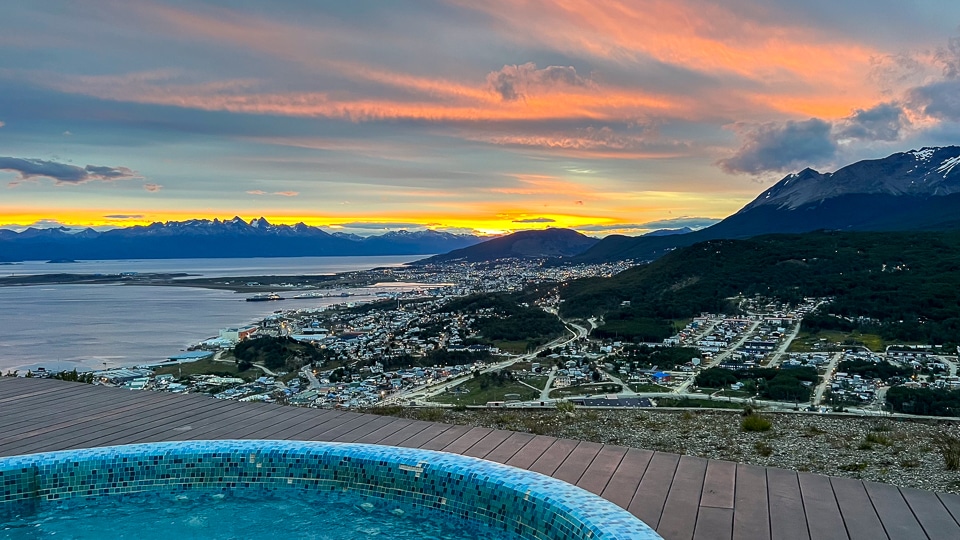
Notes on Visiting Ushuaia
Do take advantage of your time in Ushuaia to explore the town and the Tierra del Fuego National Park. (We always recommend adding an extra day couple of days on your own before any organized tour activities.)
Our Polar Latitudes arranged hotel in Ushuaia was the swanky Arakur Ushuaia Resort and Spa. It’s located 15 minutes or so up the mountain from the center of town, but well worth the shuttle bus ride. Views over the city and port look to the Chilean mountains that wrap across the south side of the Beagle Strait. The warm infinity pool up top is a spectacular place to catch the long summer sunset and views of the city and Strait.
Tours to the National Park can be booked through the hotel (these appeared to be bus tours only). For less of a production, you can simply head out on one of the easy walking trail loops starting from the hotel’s back door.
For more active hiking in the park and other adventure tours in Tierra del Fuego, we recommend contacting Tierra del Fuego Adventura.
We were lucky to spend several days in Ushuaia back in 2017. Read our tips for visiting Ushuaia here.
Day One on Board
Finally, after all the packing and preparations and travel – mixed with a dash of anxiety for us first-timers – embarkation day is a big deal. And it’s busy. You can expect to: have your photo taken as you step onboard (for your ship ID card); have a little time to unpack; grab your life jacket for safety drills at muster stations inside and out; try on the loaner muck boots that have been placed in your cabin; and find the expedition lounge on 7th deck to be outfitted with your new jacket. When you can, you'll continue unpacking and stashing clothes.
Dinner by then is most welcome. All passengers are accommodated at a single seating in the dining room that has tables for two, four, six, or more. With three meals a day (lunches can be taken in the lounge as well), there are opportunities to meet many of the interesting people this sailing has attracted.
Everyone takes to the bow and and aft decks to gaze at the sights as we set out through the Beagle Strait. And what a departure it was, threading through the strait toward the rainbow that arched from one side of the Beagle Strait to the other: our entrance to the great unknown.
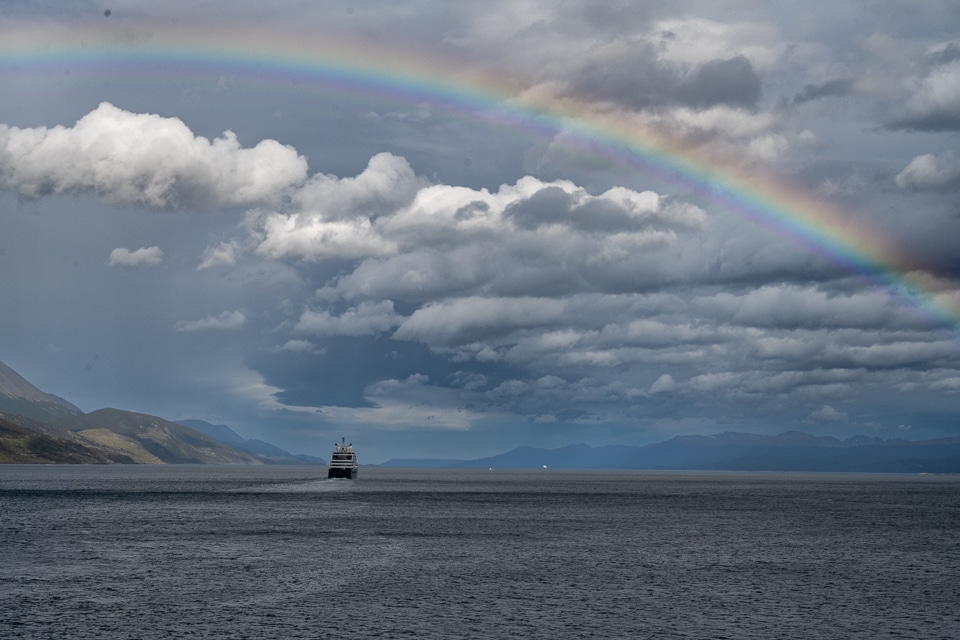
The Drake Passage
When the harbor pilot is plucked from our ship at the far edge of the strait, we know we're really on our way south. From the southernmost part of South America it is about 1100 kilometers (680 miles) to the northernmost part of Antarctica. This stretch, which take about 48 hours to cross, is the Drake Passage. The easterly currents which churn all around Antarctica are squeezed through this narrowest area, just where the Pacific and Atlantic join. Ultimately these ocean waters converge with the much colder South Sea waters. Rough seas or not, you can feel the change. Let the polar expeditions begin!
What was the Drake like? Not so bad. We will tell and retell the story of the first and roughest day, with winds of 35 knots (40 miles per hour) and swells of 5 meters (16.4 feet). What a surprise as we looked out the fourth deck restaurant window and saw spray flying off the wave crests at eye level.
One of our return days was a bit of a wild ride, too. We learned the different feel of pitching into the waves versus rolling side to side. And the combination of the two motions.
The other days and nights were relatively benign. We looked out, saw little besides the water, the waves, the sky, the swaying ship and the swinging horizon. Then, oh boy, a bird following our ship; a whale in the distance; then nothing; then whales and more birds.
On the afternoon of the second day, we saw our first iceberg and spotted land (Smith Island off in the distance). With a rush of energy, everyone stepped out onto the decks for photos. The tablet iceberg was larger than our ship, a loner drifting at sea. Ahoy the land, Smith Island, appeared first as a cloud before its hard edges emphasized its rock foundation. We'd completed our passage across the Drake.
Basic Tips for Surviving the Drake Passage
OTC, Prescription Drugs, and Treatments
Take anti-nausea (seasick) medicine before things get bad. Along with the majority of passengers, we used scopolamine patches, applying them a couple hours before hitting the heavy seas. Patches will stay on and be effective for three days.
Some passengers used standard Dramamine (mezclizine) taken orally. It’s a little less effective, perhaps, but it’s easy to control your dosing. Of course if you don’t like the patch side effects, you can remove it at any time.
ReliefBand is another product we recommend. Without drugs or drowsiness, this simple wrist band uses a little electrical pulse to lighten the effects of the motion while keeping a clear head.
Both an onboard doctor and an expedition doctor are available. They don’t stock the motion-sickness medicine for you, but in a pinch you’ll surely be able to get some from someone onboard.
Self-Care
To counter any ill feelings from motion, you can either go to bed or move around. Or try both. Remember, “one hand for the ship; one hand for yourself” at all times, meaning hang on! Your walking will improve with practice; sea legs are real. Explore the ship, have some tea or water, chat with others and enjoy the journey.
If safe, go outside on the deck for some fresh air and a view of the water and horizon. Tip: put your phone on a lanyard so it doesn’t fly overboard. Do continue to eat lightly. You’re better off with something in your stomach. Definitely consider limiting your alcohol consumption.
From our experience – and Tom is definitely not known as a boat or water guy – we didn’t feel seasick per se, just woozy. The medication made us somewhere between sleepy and knocked out. We both napped a couple times during the first day at sea, because being in bed just felt like the place to be.
The Expedition Cruise Itinerary
Any good expedition cruise itinerary will be a more of a guideline than a rule. Expect changes based on the weather and winds. Diversions might also relate to wildlife patterns and the ship’s ability to adapt for passengers’ best viewing opportunities. Essentially, the ship’s itinerary and Zodiac shore landings are tightly coordinated with other expedition ships.
Our Polar Latitudes Celebrating Antarctica cruise is a 13-day itinerary, with 10 nights aboard the ship:
- Days 1-2 Ushuaia
- Days 3- Embark
- Days 4-5 Drake Passage
- Days 6-7 South Shetland Islands*
- Days 6-10 Antarctica
- Days 11-12 Drake Passage
- Day 13 Disembark
As it happened, we skipped the South Shetland Islands for the more protected waters of the Antarctic Peninsula, and I doubt anyone complained one bit. Either way, this itinerary offers five days immersed in the wilds of Antarctica. Though we did not cross the Antarctic Circle, we managed to look down the Lemaire Channel at our most southerly point. But the channel that day was too iced in by high winds.
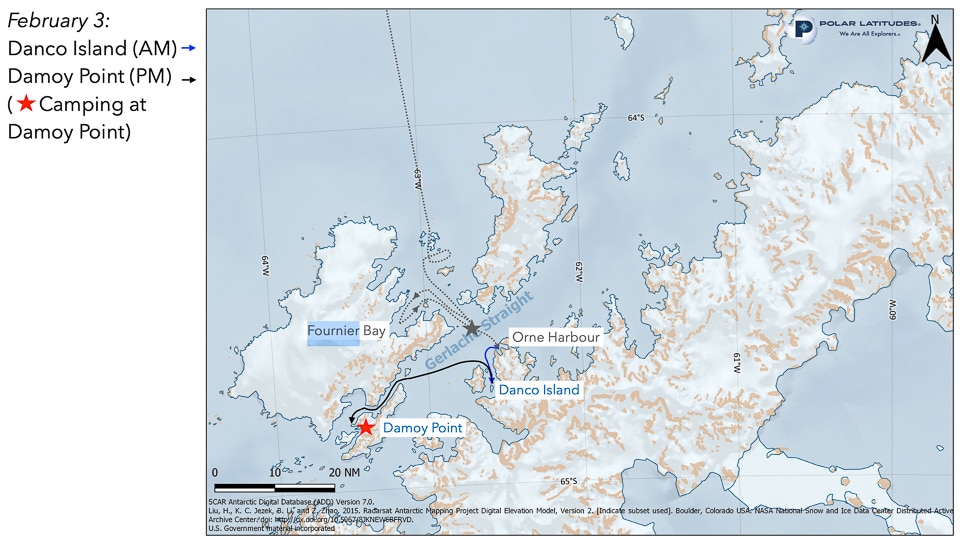
Zodiac excursions and wildlife viewing
What sets this journey to Antarctica apart from others is the time spent off the ship and out on the water or stepping onto land.
Polar Latitudes loads Seaventure with 14 Zodiacs, motorized rubber rafts which typically seat five along each side plus the guide/driver. Twice a day while we were in Antarctica, crew launched the Zodiacs, excited passengers donned their muck boots and waterproof wear, and everyone set off on an excursion.
This is the immersive experience we imagined. Day one with our experienced guide Hannah in Fournier Bay, we glided right up to four different types of seals, lounging on four different icebergs. This first Zodiac cruise opened our eyes to the immense landscapes, the towering mountains emerging above and behind the gigantic glacier cliffs at water’s edge.
The record of wildlife sightings logged back on the ship grew quickly. Our group added all these, as seen from our Zodiacs, up close: Weddell Seals, Fur Seals, Leopard Seals, Crabeater Seals, and Humpback Whales.
Lucky us.
From Zodiac excursions, the sense of perspective is constantly changing. Leave the large ship and minutes later it's dwarfed by the surrounding land. Circle icebergs as they tilt and rock; admire the shimmering blues and crystalline whites; peer at the blue gray ice below the surface, wondering how far it descends. Listen for the occasional loud booms of crevices parting, of glacial sections falling away.
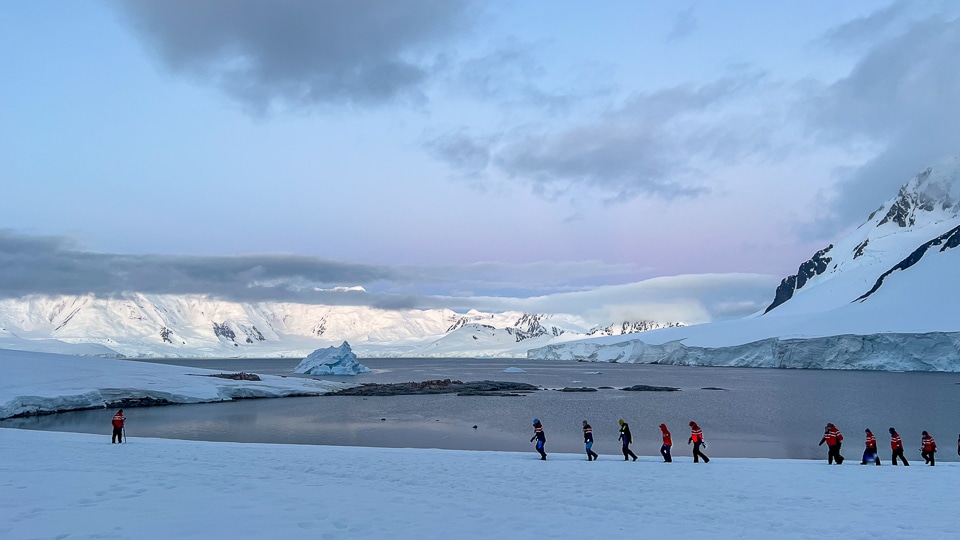
Landings
Midday, the ship re-positions for the afternoon’s excursion. If schedules and weather agree, Seaventure will pull into a bay or natural harbor within range of a landing site. Adventures at these landing sites feature human paths (as opposed to penguin highways) leading to penguin colonies, viewpoints, or both. Polar Latitudes made these hikes on the Ice easier by providing walking sticks and deft assistance getting in and out of the Zodiacs.
At different landings we were able to meet both Chinstrap and Gentoo penguins, with plenty of time to simply observe, photograph, listen. We couldn't help see our our waiting ship, looking like a little bath toy beneath the massive Antarctic backdrop.
And whoever said it’s impossible to be in a bad mood when you are watching penguins is right.
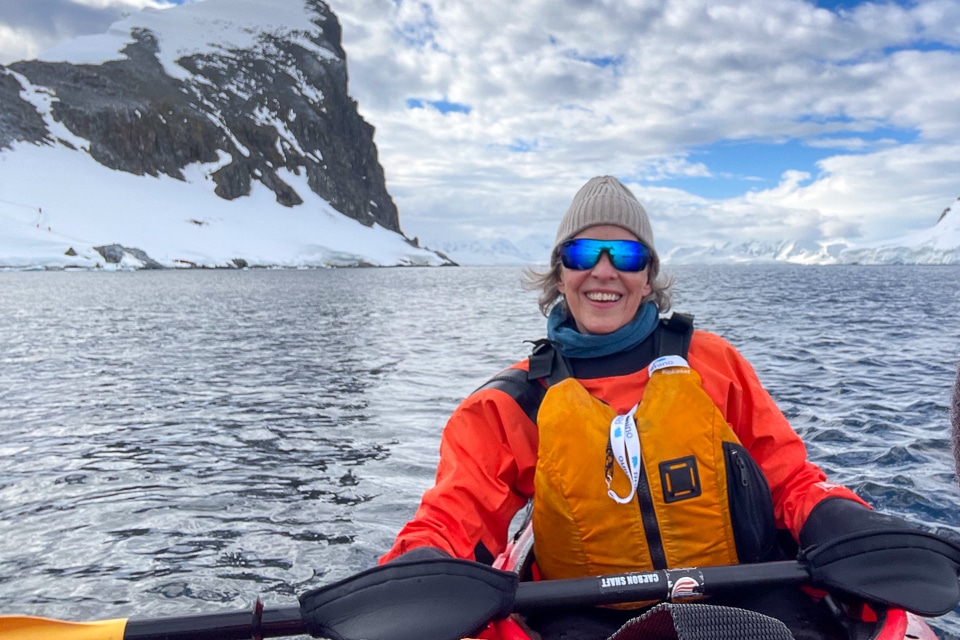
Immersive Adventures on Water and Land
Prior to sailing, passengers can sign up for kayaking or camping experiences. These opportunities are limited and incur an extra fee, so if you are interested, sign up upon booking the cruise.
Camping
Camping on the continent is a thrill if, like me, you’re interested in seeing the sky through the night, from the comfort of your sleeping bag. Polar Latitudes provides the gear: ground cloth, mattress, sleeping bag, bivy. A bivy, for those not familiar, is a protective sack for your sleeping bag, in essence a personal tent without the space to sit up. That, with the shallow “grave” you’ve dug to lower yourself out of the wind, is your protection for the night.
Success, I was able to view the long light at the end of the day, up until almost midnight. My star gazing was interrupted by some clouds and the need to tuck my head in to stay warm. But by early morning, around 2 or 3 a.m., I woke to find a penguin at the foot of my sleeping bag, just standing there looking at me. Moments later I realized the sky had cleared, pastel light was reflecting off the mountains to my right, and the tiny moon was rising. I’m not sure why it seemed to be farther away than any moon I’d seen before.
For those considering camping, you’ll want to know that the Polar Latitudes staff did everything they could to dissuade anyone who wasn’t certain about camping overnight in the open air. This camping is not in a tent, it is not glamping, and the ship cannot be summoned if you change your mind in the middle of the night. A couple tall men canceled after realizing the provided sleeping bags just didn't quite fit.
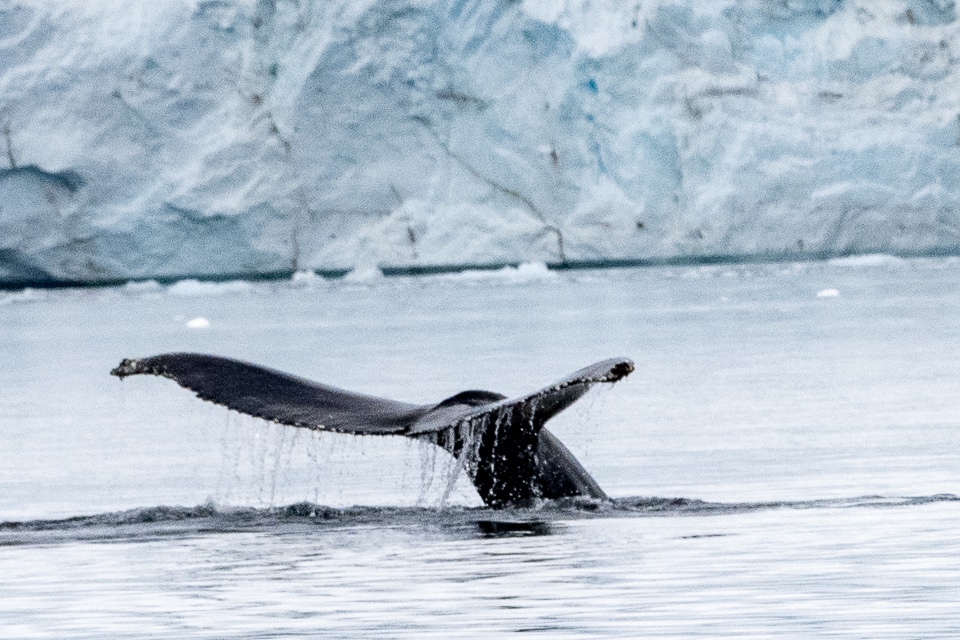
Kayaking
Explorers can sign up in advance for individual sea kayak outings or purchase “immersive kayaking”. The first option gets everyone out in a kayak once, but the exact time slot may be by lottery. The immersive kayakers go out every time the ship launches its fleet, typically twice a day while in the Peninsula area.
After wriggling into the provided dry suit and life jacket, donning a wool cap and neck gaiter, it's a thrill to paddle about freely. The views are amazing, the close-ups stunning, and the whales, gee, some of them are quite close! I never quite captured on camera the leaping penguins, synchronized swimming alongside us. Oh, I wanted to go back out for another paddle.
Polar Plunge
No charge, no advance booking required. Only the desire (aka insanity) to immerse yourself in icy water. It's only for a few seconds, really. We had a perfect day for it, with snow falling onto the water dotted with ice chunks. At one point, one of the Zodiacs had to shove an iceberg aside so we could carry on with the jumping in.
The polar plunge event is an invigorating party for everyone, as polar plungers mug for the cameras and passengers line the railing of the deck above to cheer everyone on. The expedition doctor watched (a bit anxiously) and crew strapped us each to a static line, pausing our jumps until the previous swimmer was out. (Waiting is the hardest part.) Music added to the festivities and staff offered hot drinks to the proud steaming survivors. We were so invigorated, we lingered in our wet bathing suits, draped only in a cotton robe, to watch the others and take in our apres-plunge beverage and the spirit of the day.
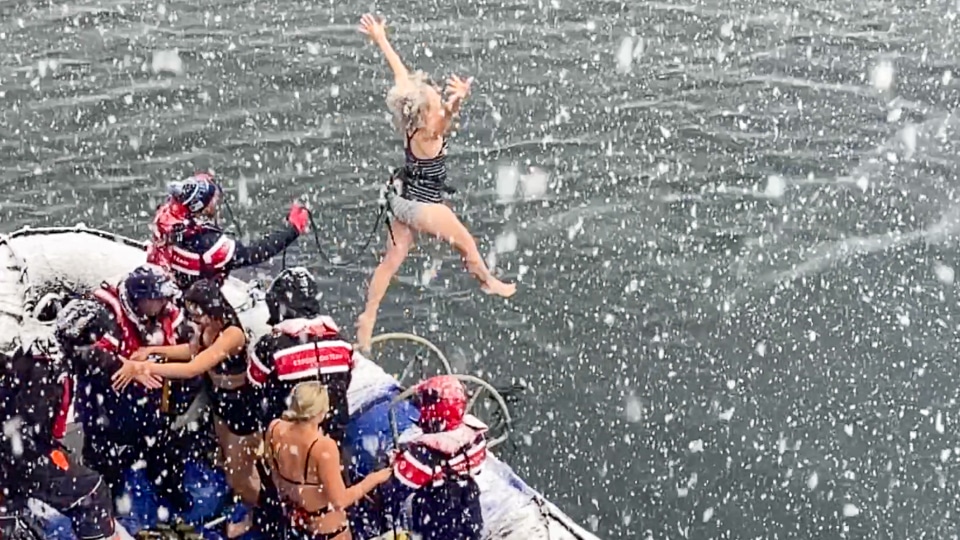
Citizen Science and Ongoing Research
An essential part of Polar Latitudes’ ethos is education and research. While working with passengers to gather data, they support ongoing research of a number of organizations. During voyages, citizen science is accomplished through observation sessions, lab sessions, lectures, and by sharing general charts and chatter. Even better, at the end of the trip, passengers are provided with thumb drives that report on all the research and offer tips for ongoing citizen science work.
During our cruise, research activities involved penguins, sea birds, humpback whales, phytoplankton, and even clouds. This work isn't conducted in a vacuum, nor does it wrap up at the end of the trip. Passengers learned how to continue to track and contribute data. Read on for details. The organizations supported include:
Happywhale
Even from passenger photos, individual marine mammals can be identified and tracked, offering a bigger picture and understanding of the Antarctic ecosystem. People can post their marine mammal photos to the Happy Whale site, the organization identifies the individual by its markings, whether it is a match or a new sighting, and then charts the whale's movements for you to follow online. Take a look at HappyWhale.com to see how much information is already available.
Southern Ocean Seabird Surveys
In cooperation with the Cornell Lab of Ornithology and their eBird app, the Polar Citizen Science Collective members regularly share their bird identifications. Studying seabirds correlates directly with the mapping of changes in the ocean itself, including currents and eddies and populations of fish and krill. On our voyage, over five data collection sessions, we counted 14 species and 115 birds.
For most of us, it was our first introduction to albatross, petrel, and penguins. For me, the Wandering Albatross that escorted us out to sea and the Brown Skua that I observed as it swooped near overhead and landed just downhill amongst some nesting Gentoo Penguins, were memorable firsts.
Birders are encouraged to use the eBird app to continue their observations. Also from home, penguin nests can be counted via remote cameras. Visit PenguinWatch.org to participate.
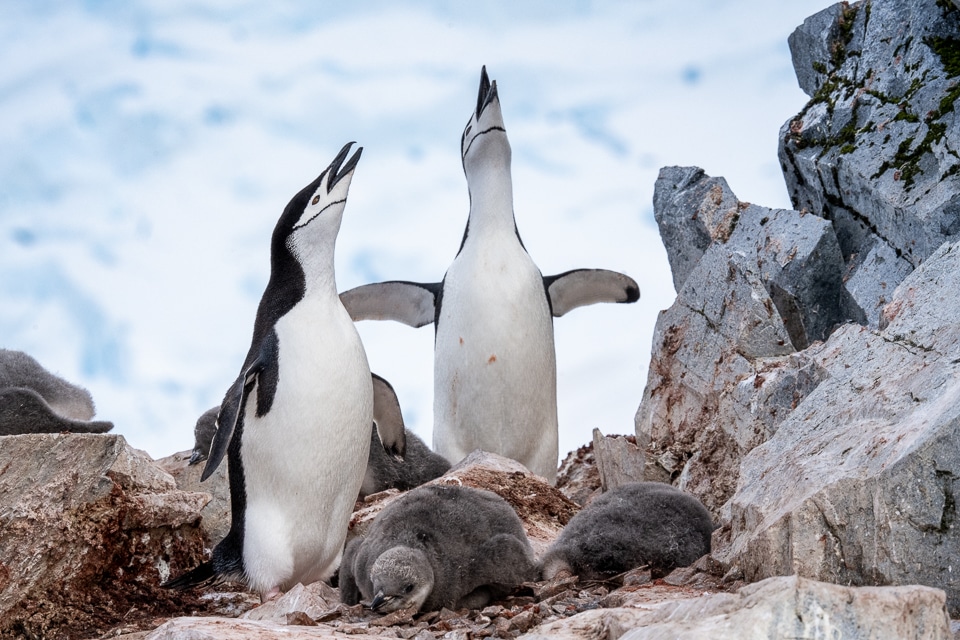
GlobeClouds
Most of the cloud observations from earth are designed to verify, or ‘ground-truth,’ the data provided by satellite. Altogether, cloud data – types, coverage, opacity and altitude – help NASA Globe Cloud teams interpret and predict the Earth’s temperatures and climate. Cloud observations can be taken from home using GLOBE Observer App for those interested in continuing the work.
Phytoplankton
Phytoplankton are those microscopic plants at the base of the food chain. To measure phytoplankton, a Secchi Disk is submerged to measure the concentration of phytoplankton in the water. The disk, on a weighted measuring tape, is lowered until it just disappears; that’s the Secchi depth reading. Why bother? Phytoplankton produce about 50 percent of the world’s oxygen and are the foundation of the marine food chain. Krill eat phytoplankton, fish eat krill, penguins and seabirds eat fish, and most of the marine mammals eat all of the above.
Phytoplankton appear to have declined by about 40 percent. This is a global study and, again, measurements can be taken by individual citizen scientists in any of the world's oceans. Just visit Secchi Disk for more info and to get the app.
Free Passage for Science Researchers
Another important way that Polar Latitudes supports science, we learned, is by offering transport to Antarctica for researchers. A certain number of berths are reserved for this purpose. On our voyage we were joined by two scientists from Oceanites. Oceanites focuses on climate change awareness, specifically addressing impacts and adaptations through the study of Antarctic penguins. (Besides sharing their work with us, we were entertained by the two Oceanites scientists' lifelike penguin calls!) Read their State of Antarctic Penguin (SOAP) report here.
Polar Citizen Science Collection
If you want to do more, participate in a fun fundraising auction on board, or follow-up by visiting the Polar Citizen Science Collective. It’s a one-stop shop, “supporting the collection of scientific data to enhance the protection and understanding of the polar regions.” Visit Polar Collective.
For more information about IAATO, tourism and responsible travel to Antarctica, listen to this interview with John McKeon, Polar Latitudes founder and executive committee member of IAATO.
Other Education Info Onboard
While the ship is at sea or re-positioning in the Antarctica Peninsula, a steady stream of lectures and stories are a welcome way to pass the time and educate yourself. We enjoyed learning about the Antarctic Treaty, IAATO, impact of krill fishing, history of the various South Pole and Antarctic explorers, e.g. “Edward Wilson and the Worst Journey in the World.”
Along one corridor on the ship we could review our actual itinerary, the daily weather, the wildlife sightings, and historic notes. Best of all, this information came home with us on a thumb drive. So we now have the data, proof of those winds and waves, the measurements of which, given the records, cannot be exaggerated over time. (I'm listening, Tom.)
Before and during the cruise, we benefited from sharing reading lists. Endurance, the story of Shackleton’s voyage in 1914-16, and The Crystal Desert, a beautiful description of the Peninsula’s natural history, are among our favorites.
Other FAQ
Finally, we can answer some of those questions we were bombarded with when we first announced our trip.
The ship. Seaventure boasts the highest ice-class rating of 1-A Super. It measures 111 meters (364 feet) in length, 17 meters (56 feet) breadth, and a draft of 4.8 meters (15.7 feet). The ship is equipped with a stabilizing system. Polar Latitude's capacity is 138 guests (though the ship was built for 160). Besides the restaurant and lounge, public spaces include a library, the citizen science lab, and a fitness center and sauna. The cabins are compact of course, but we found plenty of closet and drawer space. A desk and extra chair allowed us good space for rest and work.
Penguin smell. I’m surprised so many people brought this up. What’s the big deal? For those of us used to living through winters, any smell is a sign of life. I found it no more pungent than going to the fish market.
Cost. PL is certainly one of the more affordable Antarctic cruise options we’ve seen, and their priorities are aligned with ours, so the price is right. We appreciate that various itinerary lengths provide varying price points. See Polar Latitudes itineraries for the coming seasons here.
Physical abilities. If you want to take advantage of the immersive experiences, be sure you are comfortable getting in and out of a Zodiac. Even if you are unable to do that, you can enjoy the experience strictly from the ship and still have plenty of opportunities to participate.
How cold was it? Why would you vacation in someplace so cold? It wasn’t. It’s summer there (the best time of year to visit is November – March), and in fact it was warmer than the Minnesota we left behind. Temps were generally in the upper 20s Fahrenheit. Also note that the ship itself offers a comfortable warm environment.
Once in a lifetime. Was it a once-in-a lifetime experience? Yes and no. We don’t approach any of our travels with that thinking, but we understand that this is a place most adventurers will only get to visit once, and it's a rare traveler who even gets that chance. Now that we've had this opportunity for polar exploration, we will relive it by sharing it. But, yea, we’re hooked and hoping to return.
Send us your questions! We will enjoy reviewing and reliving this trip for a long time to come.
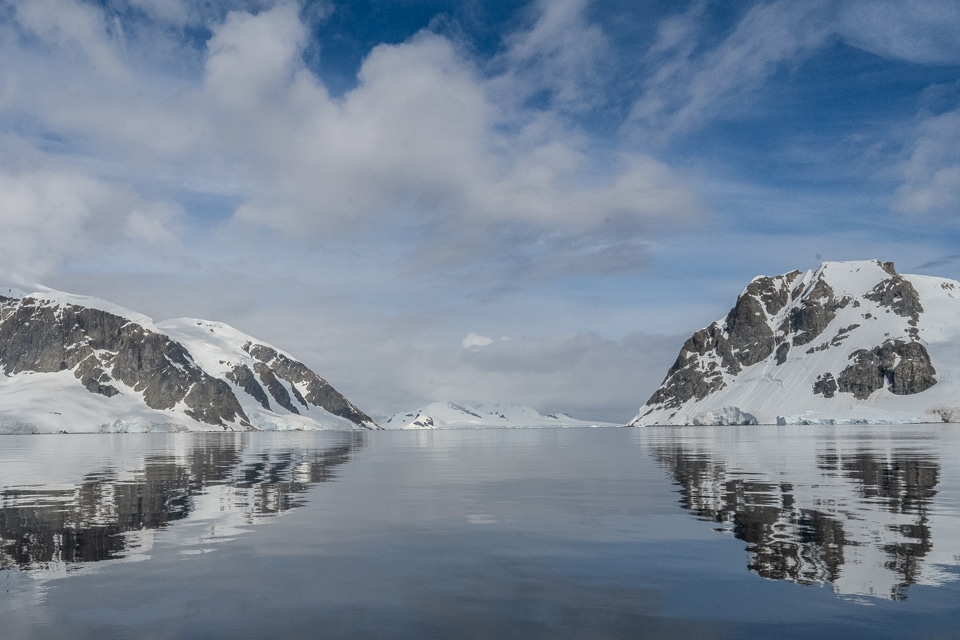
Up Your Travel Skills
Looking to book your next trip? Use these resources that are tried and tested by us. First, to get our best travel tips, sign up for our email newsletter. Then, be sure to start your reading with our Resources Page where we highlight all the great travel companies and products that we trust. Travel Accessories: Check out our list of all the accessories we carry to make getting there and being there a lot easier. Credit Cards: See our detailed post on how to choose the right travel rewards credit card for you. Flights: Start finding the very best flight deals by subscribing to Thrifty Traveler. Book your Hotel: Find the best prices on hotels with Booking.com. See all of the gear and books we like in one place on our Amazon shop.Got a comment on this post? Join the conversation on Facebook, Instagram, or Threads and share your thoughts!

